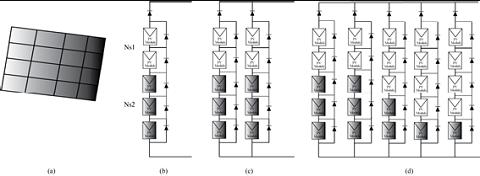


Indian Journal of Science and Technology
Year: 2021, Volume: 14, Issue: 22, Pages: 1864-1893
Original Article
AL-Wesabi Ibrahim 1,2,*, Zhijian Fang 1,2, Khaled Ameur 3, Ding Min 1,2, M B Shafik 4, Galal Al-Muthanna 5
Received Date:22 May 2021, Accepted Date:05 June 2021, Published Date:01 July 2021
Objectives: To improve the reduction of photovoltaic system's power output under various resistance load. Additionally, partial shaded conditions (PSCs) lead to several peaks on photovoltaic (PV) curves, which decrease conventional techniques' efficiency and in these (PSCs), standard equations might not be implemented entirely, therefore, the mathematical model of PV array is compulsory to modify and re-establish as well as it is compulsory to apply some methods based on artificial intelligence to develop the performance of traditional techniques. Methods: This work has modified and re-established the mathematical model of PV array under (PSCs) which are recognized and verified using MATLAB/Simulink environment. Also, heuristic algorithms (Cuckoo Search Algorithm (CSA) and Modified Particle Swarm Optimization (MPSO)) have been suggested and applied with PV system to promote output power under various resistance load, varying weather conditions and (PSCs). Moreover, these suggested algorithms can improve the dynamic response and steady-state PV systems' performance simultaneously and effectively comparing to the Modified Perturb and Observe (MP&O) and Artificial Neural Network (ANN) methods. Findings: The proposed methods are examined under various resistance load, several scenarios for (PSCs) and non-uniform irradiation levels to investigate its effectiveness. The results ensure that proposed tracker based on Cuckoo Search Algorithm (CSA) can distinguish between the global and local maximum peaks of PV system effectively with efficiency of 99% comparing to other MPPT approaches. So, all approaches mentioned above are implemented to improve the output power of PV system in Yemen. Novelty: Modified and re-established the mathematical model of PV array under (PSCs) and also, proposed a heuristic algorithms (CSA) and (MPSO)) to apply with PV system to promote maximum output power under various resistance load, varying weather conditions and (PSCs) as well as to improve the performance of (MP&O) and (ANN) methods.
Keywords
PV Systems, Maximum Power Point Tracking (MPPT), Uniform Irradiation, Partial Shading, Cuckoo Search Algorithm (CSA), MPSO, ANN, and MP&O
© 2021 Ibrahim et al. This is an open-access article distributed under the terms of the Creative Commons Attribution License, which permits unrestricted use, distribution, and reproduction in any medium, provided the original author and source are credited. Published By Indian Society for Education and Environment (iSee)
Subscribe now for latest articles and news.